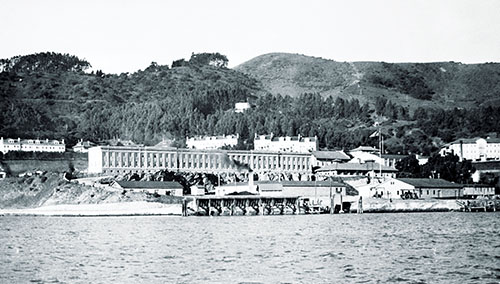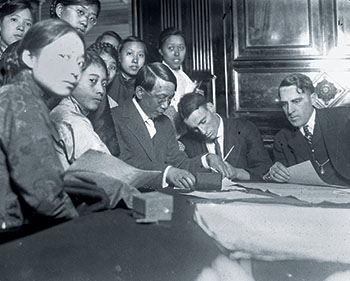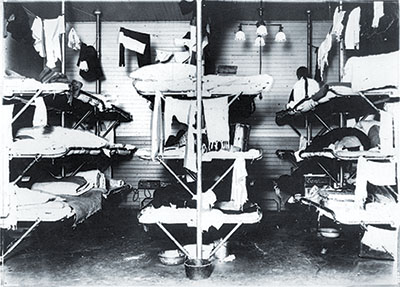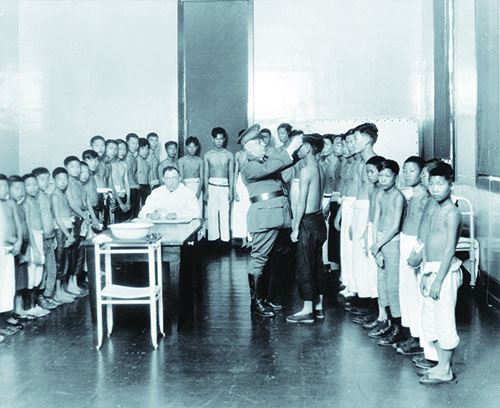On San Francisco’s Angel Island, exclusion, not admission, was the name of the immigration game
[dropcap]I[/dropcap]n San Francisco Bay, three miles north of the city’s Pier 41, is a hilly 1.2-square-mile grass- and woodland-covered island where, a millennium ago, the Coast Miwok tribe fished and hunted. In 1775, Spanish explorers christened the landmass Isla de Los Angeles. Other explorers, whalers, and crews of naval vessels used Angel Island as a base. When California was under Mexican rule, from 1821 until 1848, ranchers grazed cattle there. After the Mexican-American War, Mexico ceded its North American holdings to the United States, which remade the island as a military base, a quarantine station, and, from 1910 until 1940, an immigration station.

Angel Island Immigration Station was the primary point of ingress and sometimes unwilling egress—by deportation—for a million immigrants. Two-thirds came directly from China or Japan; the remainder took circuitous routes beginning elsewhere in Asia as well as in Europe, Latin America, and Australia.
The island’s role in immigration into the United States had its roots in anti-Chinese sentiment that surfaced when the California Gold Rush drew thousands of Chinese miners. As early as the 1850s, residents of San Francisco’s Chinatown were forming district associations to provide mutual support and defense against racial antagonism. Starting in 1864, American companies hired Chinese laborers in great numbers to build the Transcontinental Railroad and for other projects to develop the West, a necessary but not necessarily welcome workforce. In the 1870s, with the economy in recession, Americans complained that Chinese émigrés were working too cheaply, taking white men’s jobs, and looming as a moral and racial threat.
Labor leaders, politicians, and pressure groups in California led a campaign to drive the Chinese from the labor market and ban them from entering the country. In response, after nearly a century of free immigration, the United States began a period of vigorous restriction on immigration and for the first time barred a specific group by nationality, race, and class. The 1882 Chinese Exclusion Act forbade immigration by Chinese laborers and denied Chinese aliens already in the United States the chance to become citizens. A few categories of Chinese—merchants, diplomats, teachers, students, and visitors—could still enter.
The same year, the United States enacted a general immigration law that refused admission to criminals, prostitutes, lunatics, and those “likely to become public charges.” Congress gradually expanded that list to include contract laborers, polygamists, anarchists, and aliens convicted of “moral turpitude.”
Among Asian nations, only Japan, in 1907-08, was able to negotiate an informal “Gentleman’s Agreement” with the United States under which Japan regulated emigration from its shores and its colony, Korea. The accord closed the door to Japanese and Korean laborers but allowed Japanese laborers already in the United States to send for their families, a benefit pointedly left out of the Chinese Exclusion Act. By the early 1900s, nativists had formed the Asiatic Exclusion League and Americans were largely maintaining a “close the gates” attitude toward immigration, leading to restrictions aimed at South Asians, Southern and Eastern Europeans, and Filipinos.
The Chinese Exclusion Act slowed but could not stop immigration. Desperate to leave a poor, war-torn country, many Chinese took the wai lo, or “crooked path.” A favored gambit was to claim exempt status—usually as a merchant or relative of an American citizen. A lucrative business in false papers developed. Chinese hoping to pass as merchants could buy fictitious partnerships from sympathetic companies in the United States. First-time Chinese arrivals or those re-entering the country after visits home often claimed to have left behind offspring who turned out to be phantoms, creating immigration slots worth $1,000 to $2,000 when sold on the black market to “paper sons” or “paper daughters.” With false papers came coaching books of answers to questions immigration inspectors were likely to ask.

The Exclusion Act forbade ships’ passengers to land in the United States until immigration officials had inspected and approved them. From 1898 to 1910, inspection at San Francisco took place on the Pacific Mail Steamship dock in a ramshackle two-story shed notorious for being overcrowded, unsafe, unsanitary—and a breeze to escape from.
As an alternative, in 1904 Congress appropriated $250,000 to build a Bureau of Immigration station at Angel Island. The new center would be modeled on New York’s Ellis Island, which had been processing European immigrants since 1892. The Angel Island station opened in 1910, with a staff of 100 to process and detain newcomers pending results of medical and immigration inspections and hold those being deported for crimes, radical politics, or fraudulent entry.
The same occurred on Ellis Island, but in other ways the immigration stations differed dramatically. The United States, eager for white immigrants, meant for Ellis Island to welcome Europeans under laws that controlled access but did not automatically exclude anyone. Most Ellis Island arrivals stayed only a few hours for a cursory physical exam and a brief interview intended to weed out undesirables. Of more than 12 million immigrants to reach Ellis Island across 62 years, officials sent less than 2 percent home. By contrast, Angel Island was meant to keep out Chinese—and later, immigrants from elsewhere in Asia. At Angel Island, officials thoroughly examined and interrogated applicants, often detaining individuals for weeks, months, even years.
As soon as a passenger ship from abroad docked at San Francisco, immigration and medical officials boarded. Passengers in first class, usually white and wealthy, underwent visual medical examinations in their cabins, and then could go ashore. Passengers in second and third class, mostly Asian and poor, as well as the visibly ill and anyone of doubtful eligibility, boarded a ferry for the three-mile trip to Angel Island.
Passengers arriving at the island stowed their luggage, crossed a pier, and registered at the two-story administration building. The staff strictly enforced racial and gender segregation, separating whites from other races, and Chinese from Japanese and other Asians. Men and women, single or married, remained apart until their cases were settled. On the upper floor of the administration building, segregated dormitories held European men, European women, and Asian women and children. Segregated quarters in a detention building out back awaited Chinese and other Asian men. Segregation by race and gender extended to recreation yards, dining halls, and hospital wards.

Race, nationality, class, and gender often determined the length of an immigrant’s Angel Island stay, which could last from two days to two years. Europeans tended to remain briefly, enjoying better accommodations and food than their Asian counterparts. Detained on Angel Island in 1929, Canadian Ivy Gidlow wrote her sister describing her clean, white room, the hot baths, and the well-stocked library. A typical dinner consisted of vegetable soup, fresh bread and butter, roast beef or pork served with potatoes and one other vegetable, and tea or coffee.
Officialdom was harshest with Chinese immigrants, crowding them into barracks even immigration inspectors deemed unsafe and unsanitary, feeding them what the Chinese described as “pig slop,” and barring visitors from the mainland.
The Chinese, who made up as much as 70 percent of island detainees, faced longer examinations, interrogations, and detentions than any other immigrant group, averaging 18 days in detention. Appealing exclusion could mean a year on the island.
As on Ellis Island, newcomers underwent a line inspection and eye exam to detect trachoma, tuberculosis, syphilis, leprosy, and other diseases that warranted exclusion. Heart disease, hernia, “poor physique,” and other conditions that could leave a person unable to work were also grounds for exclusion. Mainstream science of the day held that Asians carried serious strains of diseases as well as parasites, so they had to go through a blood and stool examination for traces of hookworm, liver flukes, and threadworm, among others. Applicants with curable conditions could apply for treatment at the island hospital, for which they paid $5 a day. Inspectors routinely rejected more Asians than Europeans on medical grounds. When detainees died on Angel Island, officials usually released their bodies to relatives. Chinese families customarily buried immigrant dead at a San Francisco cemetery, after a few years disinterring the remains and sending the deceased back to China.
Applicants of questionable eligibility went before a Board of Special Inquiry—two inspectors, a stenographer, and, when necessary, an interpreter. Records of board hearings show a pattern of European applicants undergoing brief inquiries and obtaining admission in a day or two. So did Japanese and Korean wives, protected by the Gentlemen’s Agreement—except that board members usually asked a husband to prove he could support his immigrant spouse.
Since American law outright banned Chinese immigration, inspectors assumed Chinese applicants were trying to hoodwink them—as they often were—whether by posing as “paper sons” and “paper daughters” or by memorizing answers. In this international cat-and-mouse game, inspectors staged interrogations that could last days, probing family history, relationships, living arrangements, and village life: What are the birth and death dates of your grandparents? Who lives in the third house in the fourth row of houses in your village? How often did your father write and how much money did he send home? Examiners put the same questions to an applicant’s ostensible relatives; if both parties’ answers did not line up, rejection could follow.
When applicants appealed exclusions, their petitions went to authorities in Washington, D.C., and then the federal courts, necessitating hiring a lawyer and months more on Angel Island. Courts usually ruled in petitioners’ favor, and Chinese applicants became adept at the judicial process. Between 1910 and 1940, inspectors at Angel Island rejected 10 percent of Chinese applicants. Of those thousands, 88 percent appealed using lawyers; of their appeals, 55 percent succeeded. In 30 years, only 5 percent of applicants were returned to China.
In an example of a failed appeal, Angel Island officials detained Lee Puey You for 20 months. Lee had come to America in 1939 claiming to be an American citizen’s daughter, but her and her supposed father’s testimony did not match, triggering a deportation order. Her family hired an attorney who took an appeal to the U.S. Supreme Court—to no avail. The United States deported Lee Puey You to Hong Kong in 1940. “Everybody said that coming to America was like going to heaven, but at Angel Island they treated us Chinese like criminals,” she said much later. “Day in and day out, eat and sleep, eat and sleep. So much mental anguish. Waiting at Angel Island, I must have cried a bowlful of tears. It was so pitiful!”

In its handling of European immigrants, Angel Island more closely resembled Ellis Island. During the station’s three decades, officials processed 8,000 Russians and Jews seeking economic opportunity or fleeing religious and political persecution. To reach America, these émigrés traveled east across Siberia, China, and Japan. By the time they reached the island, refugees from the Russian Revolution or Nazism often had so little cash as to trigger a “public charges” exclusion, but with assistance from the Hebrew Immigrant Aid Society and other affinity groups they filed and easily won appeals.
A group of Russian students held for three months in 1923 wrote home praising Angel Island’s quarters and food; they also were allowed visits from friends and to put on concerts. Alice Edelstein, who as a teenager fled Vienna in 1940, remembers Angel Island as “the most beautiful place on earth.” Edelstein’s detention ended in three days when a relative sent her money for a train ticket to Milwaukee, Wisconsin.
Thanks to diplomacy, immigrants from Japan had the shortest average stay and the lowest rate of deportation among Angel Island arrivals. Between 1910 and 1924, when the United States dramatically tightened controls on Asian immigration, 65,000 Japanese gained admission, usually within a day or two. Their ranks included 10,000 “picture brides”—partners in arranged marriages with men already stateside who knew their spouses only from photographs. The regimentation and foreignness of the setting dismayed many. “We didn’t understand the language, and though they gave us three meals a day, their food did not agree with us,” Teiko Tomi said of a 1921 stay in the women’s barracks. “We all cried and cried because we didn’t know when we’d be free.”
Even before the Immigration Act of 1917 was passed to curb immigration from the subcontinent, Asian Indians had the highest deportation rate of all—55 percent of would-be entrants were barred from entering the country between 1911 and 1915. Primarily single men from the Punjab fleeing poverty and British colonialism, they tended to be rejected for hookworm or risk of becoming a public charge. Unlike the Chinese, Indians rarely had the wherewithal to appeal; unlike the Japanese, they lacked affinity groups and a powerful home government on their side.
But in the land of the red, white, and blue, other colors, specifically green and gold, spoke forcefully. In 1915, Vaishno Das Bagai, an educated high-caste Hindu from Peshawar, where he had worked to end British rule, sailed to San Francisco with his family. The Vaishnos arrived on a Saturday; no immigration inspectors were on duty, relegating the family to three days on Angel Island. However, as soon as Vaishno revealed that he had $25,000 in gold, the gates opened.
On August 12, 1940, a basement short circuit burned down the immigration center’s administrative building. Angel Island Immigration Station closed; processing shifted to 801 Silver Avenue in San Francisco. Once the United States entered World War II, authorities used Angel Island’s surviving structures to process and house GIs, Axis prisoners of war, repatriates, and enemy aliens bound for inland internment camps.
In 1943, as a goodwill gesture to ally China, Congress repealed the Exclusion Act; now Chinese aliens could become citizens—but only 105 Chinese a year could immigrate, compared with Britain’s annual quota of 34,007. America maintained nation-specific immigration quotas until the Immigration and Nationality Act of 1965 abolished them, allowing Asian countries a maximum of 20,000 immigrants a year, the same as other countries, based on a preference system that favored family reunification, so that family members of American citizens could enter as nonquota immigrants with no numerical limit.
In 1954, after ceding Angel Island to California, the federal government installed a Nike anti-aircraft missile battery there. The battery was decommissioned in 1962, and a year later, the state made the island a park. Announcement of plans to demolish the old immigration buildings and build a picnic area spurred Asian-American activists to campaign to save the structures, an effort that lasted decades. In 1997 the site received National Historic Landmark designation. A $40 million fundraising effort underwrote preservation of the detention building, installation of museum exhibits, and conversion of the hospital building into the Pacific Coast Immigration Center. Since February 2009, the renovated Angel Island immigration site has been open to the public. ✯
This story was originally published in the November/December 2016 issue of American History magazine. Subscribe here.





